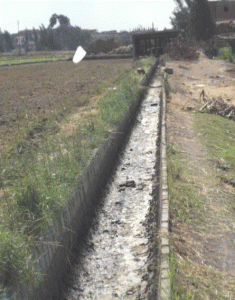Egypt is modernizing its irrigation systems and management practices from supply-based to demand-based irrigation water supply. The expected result is that farmers will take in less irrigation water, as they are assured that water is continuously available. During this project, the consequence of changing from supply-based irrigation to demand-based irrigation on water availability, crop production, groundwater levels and water quality was investigated. The impact of significant infrastructure investments on the overall utilization of water resources was assessed. The outcome is relevant for up-scaling the modernization program towards the entire Nile Delta.
The objective of this study is to carry out an in-depth assessment of the effects of investments in quaternary, tertiary and secondary-level improvements on farmers’ water availability, in terms of quantity, quality, reliability and equity in distribution, and yields of smallholder farmers by studying the winter season 2010/11 and the summer season 2011. Two command areas will be studied: W-10 with, and Daqalt without, modernized quaternary canals. Both command areas comprise about 4,500 farmer households and 2,600 hectare of irrigated land. A suitable third command area without canal modernization will be selected as a reference area.
The assessment will be carried out based on remote sensing analysis and simulation models. A related objective is to facilitate close collaboration with staff of the relevant Egyptian authorities and provide capacity building in the use of the methodological approach for possible subsequent application in other areas of the Nile Delta and beyond where such modernization interventions are being planned. The insights gained on boosting crop production and achieving water savings will feed into the proposed Bank-supported Farm-level Irrigation Modernization Project (FIMP) which aims to modernize farm-level quaternary canals and improve irrigation and cropping practices on 80,000 ha farmed by about 140,000 households in the Nile Delta.

The combined remote sensing and hydrological study will be conducted for 2010/2011. W10 and Daqalt command areas have undergone the modernization process at secondary and tertiary level. The W10 area covers in addition also lifted quarternary canals and has a continuous flow up to the farm gate, so that all farmers have immediate access to irrigation water, in the case they wish so. W10 and Daqalt will be used as a representative area for the new “attitude” of Egyptian irrigators. This attitude will be expressed into consumptive use, head-tail uniformity and crop production.
FutureWater is currently working on the project part on hydrology, using simulation models. We will use the SWAP code to set up field-scale hydrological models to calculate water and salt transport throughout the soil-water-system. We will include transpiration calculations and crop yields. Evapotranspiration estimates will be compared to data from the remote sensing analyses.
Related publications
2012 - FutureWater Report
Egypt: Assessing the Effects of Farm-Level Irrigation Modernization on Water Availability and Crop Yields
Simons, G.W.H., W. Terink, H. Badawy, G.A.P.H. van den Eertwegh, W.G.M. Bastiaanssen

